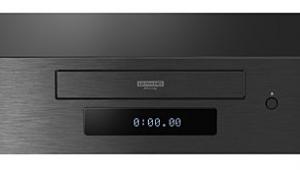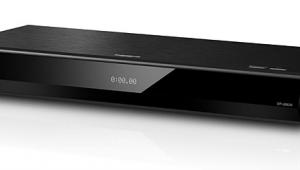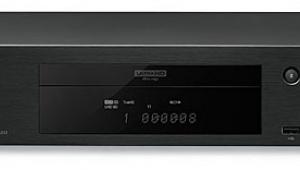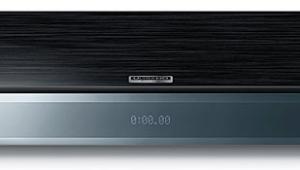I'm shocked how Sound & Vision editors can allow a review like this to be published. How can you review a top of the line 4k Ultra Hd Blu Ray player with a display that's not HDR or wider color capable. HDR and wider color is way more important than the upgrade in resolution for picture quality. Definitely not up to usual Sound & Vision standards. What's next, going to review a Dolby Atmos capable receiver with just 5.1 speakers?
Panasonic DMP-UB900 Ultra HD Blu-ray Player Page 2
 Setup
Setup
To test the DMP-UB900, I used its HDMI 2.0a output to connect a Vizio M65D0 Ultra HDTV and the second HDMI out to route audio to an Anthem preamp/processor, configuring each jack for video- and audio-only settings respectively in the HDMI Output Mode menus. For a network connection, I ran an Ethernet cable directly from my router to the player’s LAN port. (While my home’s Wi-Fi connection is reasonably robust, I find 4K streaming performance to be much more reliable when using a wired connection.)
The DMP-UB900’s HDMI menu provides settings to select output resolutions up to 4K/60p along with 4:4:4 (12-bit) or 4:2:0 (8-bit) color depending on the capabilities of your display. There’s also an Advanced Settings submenu with options to select Deep Color and HDR output.
A Video Settings menu provides additional adjustments, including advanced settings to tweak sharpness and noise reduction, along with basic ones for luminance, gamma, and color. The player also provides two picture memories to store and recall your adjustments. To use the Panasonic as a DLNA client, I fired up a media server application on my Mac (JRiver Media Center 21), pressed the DLNA button on the player’s remote control, and was able to browse and stream all manner of ripped and downloaded music from my digital library.
There was also a wide range of settings provided in the DMP-UB900’s Audio setup menu. The player has a High Clarity Sound mode that shuts off both video circuits and the front-panel display to reduce noise when playing music, and offers a range of Sound Effects settings to upsample lower-res files to up to 192-kHz/32-bit resolution or apply processing modes that model the effects of vacuum tube amps on audio signals.
Performance
During my testing of the DMPUB900, I had the opportunity to compare its performance with Samsung’s UBD-K8500 player. Watching a 4K UHD Blu-ray of Sicario, the image looked equally crisp, clean, and dynamic with both players—I found it nearly impossible to discern any video quality differences. In a scene where Kate is grilled in a meeting room by a group of CIA operatives, for example, the grizzled texture of the government agents’ faces came through clearly, even when depicted through a plate glass barrier. It didn’t matter if I played this scene using the Panasonic or the Samsung, it looked strikingly good on both.
Where the Panasonic did display an edge over the Samsung was in 1080p Blu-ray playback. When I watched a disc of The Wailing, a Korean film that could be best described as a comic-horror detective story, the beautifully shot scenes of the rural countryside were rendered in crisp 4K resolution by the Panasonic, with fine gradations of color and shadow detail clearly coming across. Played on the Samsung, the same disc looked notably less crisp and three-dimensional.
Part of the DMP-UB900’s excellent performance with conventional Blu-ray has to do with its sharpness adjustments, which can be applied independently to mid or high frequencies in the video signal and help punch up detail without adding ringing artifacts. The player’s noise reduction adjustments also help to clean up images without making them look overly soft in the process. I was less blown away by the player’s HDR-to-SDR conversion feature. When I checked this out with an HDR disc on a regular HDTV, the picture simply looked dim. And when I used the feature’s brightness adjustment to restore an acceptable level of light output, shadows lost depth and the image became less dynamic.

Comparing the Panasonic’s audio performance with that of Pioneer’s BDP-88FD, another audiophile-oriented Blu-ray player that cost $2,000 when it was released, the Panasonic held up remarkably well. Listening to Aimee Mann’s “Save Me” from the CD soundtrack to the film Magnolia, the Pioneer was able to provide an authoritative sense of instrument placement in the mix, but its sound seemed dry and analytical. The DMP-UB900, in contrast, conveyed a distinct warmth that was a much better fit for the vocals on this song. I also enjoyed listening with the Sound Effects settings enabled, particularly the vacuum tube amp presets, which added an appealing sense of depth on certain tracks.
Panasonic’s player also performed well when I tapped its DLNA client feature to stream hi-res audio from my computer over a wired network. Listening to jazz pianist Brad Mehldau’s ballad “Little Person,” an 88.2-kHz/24-bit HDtracks FLAC download, the sound was liquid and warm, but also revealing of fine textures such as the pressure of fingers pushing down on piano keys. There was an excellent sense of separation between the instruments, even when acoustic bass and piano sync up near the song’s end and play the same phrase in lock-step.
Conclusion
With the arrival of Panasonic’s DMP-UB900, we finally have a player appropriately suited up to deliver the quality potential of not just Ultra HD Blu-ray, but regular Blu-ray, a format many enthusiasts have an investment in and will continue to watch for years to come. In addition, the DMP-UB900 sounds great when playing both hi-res audio files and CDs. Add to that list a full-featured remote control and flexible connectivity options, and it becomes clear which Ultra HD Blu-ray player is leading the pack—at least until models that also support Dolby Vision start to arrive.

- Log in or register to post comments



I stand corrected, the Vizio is capable of accepting an Hdr10 and Dolby Vision signal. What I was trying to get across is why would you not review the Ub900 with a more capable tv. How many consumers are going to buy a $600 4k blu ray player for their $1,200 tv? This is the kind of device for the true enthusiasts. Just thought this player deserved to be mated with a better display. Sorry but this review just got under my skin. Thanks for the reply and correcting my error.

"Of the three Ultra HD Blu-ray players A/V enthusiasts currently have to choose from, " I would ask why you failed to include the oppo upd-203 uhd Blu ray player which is now shipping and also the Xbox one s which is a very capable uhd player. Just a bit misleading when in reality you do have a couple other options

I just checked out the Oppo website, and their new UHD player has everything the Panny has and more, including a future Dolby Vision upgrade, SACD/DVD-Audio compatibility, 2 USB 3.0 ports on the rear (1 USB 2.0 on the front), and even a backlit remote. It's also $51 cheaper, but it doesn't have a SD card reader, but with the money one saves, they could always buy this handy little device - which costs about $10 on the Big A - for easy viewing of their photos on an SD card using a USB slot:
https://www.transcend-info.com/products/Product_detail.aspx?no=396
Hey, I don't work for Oppo or Transcend. I just know a great bargain and superior value when I see one.

Just wanted to add that the Transcend card reader mentioned above has a lot more negative reviews than I originally noticed (the unit seems to run hot and some have complained about data loss), but there are many similar items from other companies that do the same job better at basically the same low price, so a UHD player without an SD slot is not a big deal.


Article date on the website is January 18th

Al, when you use the HDMI output to connect to your Anthem preamp/processor, aren't you bypassing the Panasonics DAC when streaming music from your DLNA server and using the Anthem's internal DAC instead? The quality of the streamed music you hear is really based on the Anthem and not from the Panasonic? In essence, music should sound exactly like the same music streamed directly to the Anthem. Am I wrong?


I enjoyed review along with the YouTube HDTV Channel direct 203 comparison. One year later not much has changed. I gladly went with UB900 for picture delivery today, not a promise of the future firmware upgrade with movies yet to be made. Enthusiast are very loyal to branding at times. Having upgraded from a 1080P plasma in 2009 these nuances are lost on me.






























































